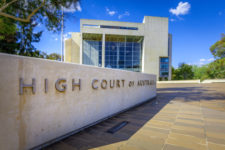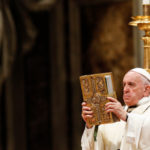Why Pell Walked: The High Court’s Findings

The full-bench of the High Court of Australia unanimously entered verdicts of acquittal in favour of appellant George Pell on 7 April 2020, in relation to child sexual offences in respect of which a jury unanimously found him guilty in December 2018. The seven justices of the court found that it was not open for a jury to be satisfied beyond reasonable doubt of the offences charged – that the jurors should have ‘entertained a doubt’.
And rather than refer the case back to the Victorian County Court for a retrial, the High Court allowed Mr Pell to be set free.
Jurors in the County Court had found Pell guilty of one charge of sexual penetration of a child under the age of 16, as well as four counts of committing an act of indecency with or in front of a child under 16 years of age.
It was the second time the former Archbishop of Melbourne had been tried on these charges, as the first trial resulted in a hung jury.
The alleged offending was said to have taken place between July 1996 and March 1997, at East Melbourne’s St Patrick’s Cathedral, with the complainants being two choirboys referred to as A and B. Choirboy A first made the accusations in June 2015, at which time B had already passed away.
Allegations
Choirboy A asserted that the first four assaults were perpetrated against himself and fellow choirboy B following a Sunday mass, when they’d both taken part in a choir performance in the early days after Pell’s appointment to Archbishop of Melbourne in 1996.
At the end of each Sunday mass, a procession consisting of the choir, the altar boys, the Archbishop and other clergy members would make its way out of the cathedral to change from official robes in the various sacristies and robing rooms located out the back of the church.
But on the day in question, A and B allegedly broke away from the procession and made their way to the priest’s sacristy via a different route. And once inside, they managed to find a bottle of red altar wine and began to swig at it.
According to A, the Archbishop walked into the room and reprimanded the boys for drinking the wine, before pulling out his penis and forcing it into B’s mouth for a number of minutes. According to the complainant, the doing the same to A. It was also claimed Pell then fondled A’s penis, whilst doing the same to himself.
The fifth charge dealt with another occasion at least a month afterwards, when A was walking in the procession after Sunday mass. A asserted that Pell walked up to him during the procession, pushed him up against a wall and squeezed his penis and testicles in a painful manner.
A testified to this effect during the first trial, and the footage of this was submitted as evidence during the second. On 18 December 2018, before Chief Judge Peter Kidd, the County Court jury returned a unanimous verdict of guilty on all five charges, after deliberating for almost five days.
Supreme Court appeal
Mr Pell’s lawyers appealed the verdicts to the Court of Appeal in the Supreme Court of Victoria in August 2019, on the ground that it was unreasonable for the jury to come to such a conclusion based on the evidence available to it.
The majority of the appeals court – Justices Anne Ferguson and Chris Maxwell – found that A was a credible witness. Their Honours reasoned the former choirboy’s claims were supported by his knowledge of the inside of the priest’s sacristy. And on 21 August, they dismissed Pell’s appeal.
However, in dissent, Justice Mark Weinberg found that there were a number of inconsistencies in A’s story. His Honour concluded on that basis that A’s evidence shouldn’t have been accepted by the jury, as a reasonable doubt was apparent.
High Court appeal
Mr Pell’s legal team then appealed the Court of Appeal’s decision to the High Court of Australia. They did so on two grounds. The first was that the majority had made as error by finding it was necessary for Pell to establish that it was an impossibility for the assaults to have taken place in order to cast reasonable doubt on whether they actually occurred.
The second ground was that the appeals court had been mistaken in finding the verdicts were not unreasonable, as there still remained “a reasonable doubt as to the existence of any opportunity for the offending to have occurred”.
High Court judgement
The full panel of High Court justices considered the usual procedures that the newly appointed Archbishop Pell, the other clergy members and the rest of the procession would undertake after a regular Sunday mass.
The prosecution had established at trial that the first incident would have had to occur on either 15 or 22 December 1996, as these were the first days the new archbishop attended Sunday mass at the cathedral, and based on A’s testimony, the alleged assault took place straight after mass.
The first point the High Court found cast doubt on A’s version of events was that it was Pell’s habit directly after mass to appear on the cathedral steps to meet with the congregants. And Pell’s master of ceremony, Father Portelli, placed the new Archbishop there on both days in question.
Another key factor considered by the court was the church practice of always having someone accompany the Archbishop when he was in his official mass robes. This accompanying role was carried out by Father Portelli, who would also help Pell disrobe in his sacristy afterwards.
And the third factor was that the priest’s sacristy – the scene of the alleged assault – was a “hive of activity” in the ten to fifteen minutes following mass with all procession participants coming and going, at the very same time the alleged abuse was alleged to have occurred.
The High Court justices also questioned the likelihood of the second indecent assault, which was said to have occurred on 23 February 1997, finding it hard to believe that the rest of the procession would have missed Archbishop Pell “pinning a 13 year old boy to the wall”.
Indeed, not only did Portelli testify that he recalled Pell being on the steps on the two dates when the first alleged incident could have transpired, but he also testified that he could remember being with the Archbishop during the procession on the alleged date of the second assault.
Verdicts of acquittal entered
“Making full allowance for the advantages enjoyed by the jury, there is a significant possibility in relation to charges one to four that an innocent person has been convicted,” the High Court justices concluded following their consideration of the first alleged incident.
And in considering the evidence surrounding the second alleged assault, their Honours found that “it was evidence which ought to have caused the jury, acting rationally, to entertain a doubt as to the applicant’s guilt of the offence charged”.
On 7 April this year, the High Court justices ordered the appeal be allowed, the unanimous verdict of the jury and majority judgement of the Victorian appeals court be set aside, that Pell’s convictions be quashed and verdicts of acquittal be entered.








